|
|
|
Sort Order |
|
|
|
Items / Page
|
|
|
|
|
|
|
| Srl | Item |
| 1 |
ID:
166717


|
|
|
|
|
| Summary/Abstract |
Heat decarbonisation is the biggest challenge facing UK energy policy. This paper presents an area-based modelling approach to heat electrification using 17,741 dwellings in the city of Newcastle upon Tyne as a case study. The presented framework has been developed so as to address local energy policy questions on the impact of domestic electrical heating options. These questions reflect significant under-researched challenges such as the quantification of peak electricity demand for heat pumps based electrification options. The presented results show that the electrification of heat at city-scale will have a substantial impact on the local electrical grid infrastructure and provide a first indication of what the potential additional mean and (winter) peak household electricity demand ranges (i.e. 59–95%. This is significantly lower than what might be ascertained from existing literature). Furthermore, the results show that emission savings will be achieved with all electrification options studied but achieving the city's ambitious decarbonisation goals will require more exploration of the urban energy landscape. The paper further underpins the significance of sub-city modelling by enabling policy makers to identify housing neighbourhoods at LV sub-station for area-based delivery. Finally, an integrated modelling approach to cope with forthcoming energy system design challenges at LV scale is suggested.
|
|
|
|
|
|
|
|
|
|
|
|
|
|
|
|
| 2 |
ID:
166542
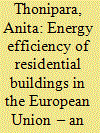

|
|
|
|
|
| Summary/Abstract |
Despite a common EU directive on energy efficiency in residential buildings, levels of energy efficiency differ across European countries. This article analyses these differences and investigates the effectiveness of different energy efficiency policies in place in those countries. We firstly use panel data methods to explain average yearly energy consumption per dwelling and country by observable characteristics such as climatic conditions, energy prices, income, and floor area. We then use the unexplained variation by sorting between-country differences as well as plotting within-country changes over time to identify better performing countries. These countries are analysed qualitatively in a second step. We conduct expert interviews and examine the legal rules regarding building energy efficiency. Based on our exploratory analysis we draw a number of preliminary conclusions. First, we suggest that regulatory standards, in conjunction with increased construction activity, can be effective in the long run. Second, the results suggest that carbon taxation represents an effective means for energy efficiency. In this regard, the scope of the carbon tax plays a crucial role. We find evidence that a tax of 30 € and a tax of 120 € per ton of CO2 cause markedly different reductions in energy consumption.
|
|
|
|
|
|
|
|
|
|
|
|
|
|
|
|
| 3 |
ID:
111378


|
|
|
|
|
| Publication |
2012.
|
| Summary/Abstract |
Transforming the housing stock to a low energy performance is a key priority in the context of sustainable development and a post-carbon transition. However, in terms of its practical implementation it, firstly, faces a number of complex institutional barriers, while, secondly, involves a risk of being dominated by a narrow technocratic agenda for energy/carbon reduction that may overtake the socially progressive pursuits of housing policy. Energy efficiency strategies for the residential sector must, therefore, be multidimensional, fully synergised with housing policy, and incorporating the principles of equity, access and a balanced geographical development. This paper discusses a strategic policy framework, which was designed by the United Nations Economic Commission for Europe (UNECE) to address those important needs in international policy. The document - Action Plan for Energy-efficient Housing in the UNECE Region - outlines a number of goals, targets and actions structured at three dimensions: (i) governance and finance, (ii) technological advancement, and (iii) access and affordability. The Action Plan provides a comprehensive and integrated framework, based on which governments can shape their own pathways towards a sustainable low-energy residential sector.
|
|
|
|
|
|
|
|
|
|
|
|
|
|
|
|
| 4 |
ID:
112285


|
|
|
|
|
| Publication |
2012.
|
| Summary/Abstract |
With rapidly increasing energy consumption attributed to residential buildings in South Korea, there is a need to update requirements of the building energy code in order to improve the energy performance of buildings. This paper provides some guidelines to improve the building energy code to better select glazing types that minimize total energy use of residential buildings in Korea. In particular, detailed energy simulation analyses coupled with economical and environmental assessments are carried out to assess the thermal, economical, and environmental impacts of glazing thermal characteristics as well as window sizes associated with housing units in various representative climates within South Korea. The results of the analyses have clearly indicated that selecting glazing with low solar heat gain coefficient is highly beneficial especially for large windows and for mild climates. In particular, it is found that using any double-pane low-e glazing would provide better performance for windows in residential buildings than the clear double-pane glazing, currently required by the Korean building energy code.
|
|
|
|
|
|
|
|
|
|
|
|
|
|
|
|
| 5 |
ID:
192803
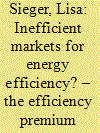

|
|
|
|
|
| Summary/Abstract |
On the market where prospective renters meet dwelling offers, competitive forces and rational behavior on both sides would imply that the monthly basic rent should reflect differences in expected monthly heating costs – other things being equal. We test this hypothesis by specifying a hedonic price model reflecting a total-cost-of-renting perspective. Drawing on 844,229 apartment listings for rent from 2014 to 2020 on a small spatial scale, we find a premium for more energy-efficient apartments; however, it is rather small. If the energy performance score decreases by 10 kWh/m2a, the monthly basic rent increases, on average, by roughly €0.01 per square meter living area. The expected energy cost savings thereby exceed the premium by a factor of three to seven. Rather, we find discounts of up to 9.2 % if apartments use heating technologies that are known to be inefficient. We explore various explanations for these outcomes, considering both landlord and renter behavior.
|
|
|
|
|
|
|
|
|
|
|
|
|
|
|
|
| 6 |
ID:
186457
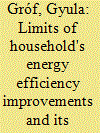

|
|
|
|
|
| Summary/Abstract |
Many energy-efficiency programs at the national and EU levels target the residential building sector. Investment in the renovation of buildings results in increased energy efficiency and can minimise energy utilisation when up-to-date technique and accurate planning is performed. The realisation depends on many subjects. One critical objective in the planning process is the financial status of the families living in the building stock subject of the renovation projects. A complex approach is essential in housing renovation programs, and the consequences of different energy policies in each country should be considered. This study reports the possible level of Hungarian prebound and its consequence on the energy efficiency mortgage loans. The heating expenditure varies by household's income situation and/or the dwelling's technical characteristics. A mixed picture was found, reducing available expenditure and, typically, higher monthly savings rates for smaller dwellings. We found that the prebound and rebound effects and credit constraints might limit a nationwide energy renovation program. Furthermore, the fixed residential energy price policy can impair the effectiveness of housing renovation programs. We found a minimal positive effect on banks' expected credit loss and the regulatory capital requirement on home energy-efficiency improvements.
|
|
|
|
|
|
|
|
|
|
|
|
|
|
|
|
| 7 |
ID:
101462


|
|
|
|
|
| Publication |
2010.
|
| Summary/Abstract |
This paper describes a method of identifying and weighting indicators for assessing the energy efficiency of residential buildings in China. A list of indicators of energy efficiency assessment in residential buildings in the hot summer and cold winter zone in China has been proposed, which supplies an important reference for policy makings in energy efficiency assessment in buildings. The research method applies a wide-ranging literature review and a questionnaire survey involving experts in the field. The group analytic hierarchy process (group AHP) has been used to weight the identified indicators. The size of survey samples are sufficient to support the results, which has been validated by consistency estimation. The proposed method could also be extended to develop the weighted indicators for other climate zones in China.
|
|
|
|
|
|
|
|
|
|
|
|
|
|
|
|
| 8 |
ID:
104981


|
|
|
|
|
| Publication |
2011.
|
| Summary/Abstract |
Residential building energy use is an important contributor to greenhouse gas emissions and in the United States represents about 20% of total energy consumption. A number of previous macro-scale studies of residential energy consumption and energy-efficiency improvements are mainly concerned with national or international aggregate potential savings. In this paper we look into the details of how a collection of specific homes in one region might reduce energy consumption and carbon emissions, with particular attention given to some practical limits to what can be achieved by upgrading the existing residential building stock. Using a simple model of residential, single-family home construction characteristics, estimates are made for the efficacy of (i) changes to behavioral patterns that do not involve building shell modifications; (ii) straightforward air-infiltration mitigation measures, and (iii) insulation measures. We derive estimates of net lifetime savings resulting from these measures, in terms of energy, carbon emissions and dollars. This study points out explicitly the importance of local and regional patterns in decision-making about what fraction of necessary regional or national emissions reduction might be accomplished through energy-efficiency measures and how much might need to concentrate more heavily on renewable or other carbon-free sources of energy.
|
|
|
|
|
|
|
|
|
|
|
|
|
|
|
|
| 9 |
ID:
177399
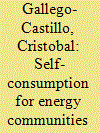

|
|
|
|
|
| Summary/Abstract |
European climate polices acknowledge the role that energy communities can play in the energy transition. Self-consumption installations shared among those living in the same building are a good example of such energy communities. In this work, a regional analysis of optimal self-consumption installations under the new legal framework recently passed in Spain is performed. Results show that the optimal sizing of the installation leads to economic savings for self-consumers in all the territory, for both options with and without remuneration for energy surplus. A sensitivity analysis on technology costs revealed that batteries still require noticeably cost reductions to be cost-effective in a behind the meter self-consumption environment. In addition, solar compensation mechanisms make batteries less attractive in a scenario of low PV costs, since feeding PV surplus into the grid, yet less efficient, becomes more cost-effective. An improvement for the energy surplus remuneration policy in the context of the current legislation was proposed and analysed. It consists in the inclusion of the economic value of the avoided power losses in the remuneration.
|
|
|
|
|
|
|
|
|
|
|
|
|
|
|
|
| 10 |
ID:
149938


|
|
|
|
|
| Summary/Abstract |
Nowadays, in Europe, the main challenge is not only the construction of new high performing buildings, but also the promotion of proper retrofit actions on existing buildings. In the on-going transition towards low carbon cities, tools to support local municipalities are fundamental.
|
|
|
|
|
|
|
|
|
|
|
|
|
|
|
|
| 11 |
ID:
126512


|
|
|
|
|
| Publication |
2013.
|
| Summary/Abstract |
The landlord/tenant dilemma arises when the interests of landlords and tenants misalign and is one of the greatest barriers hindering the development of sustainable renovation of residential buildings in Europe. The aim of this research is to investigate how regulatory changes and contractual solutions can help solve the landlord/tenant dilemma in relation to sustainable renovation of residential buildings, and how the general awareness of sustainable renovation can be increased. Particular focus is on whether tools like energy performance contracting and energy labeling can help solve the landlord/tenant dilemma. The research was done in relation to the specific situation in Denmark, but theory, information and experiences from other countries were included. The results show that there are plenty of opportunities to overcome the landlord/tenant dilemma, but principal/agent problems can only be overcome with a package solution. In the Danish national context the package solution must consist of legislative changes, financial incentives and better dissemination of information. Therefore, an array of different tools must be integrated and used in cooperation to overcome the dilemma.
|
|
|
|
|
|
|
|
|
|
|
|
|
|
|
|
| 12 |
ID:
166320
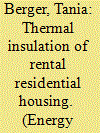

|
|
|
|
|
| Summary/Abstract |
Increasing energy efficiency of buildings by renovation and thermal insulation is widely seen as means to lessen energy demand and to increase thermal comfort. However, costs of renovation and the dangers of displacing low income, energy poor households due to rent increases are generally not addressed in literature on benefits of thermal insulation.
|
|
|
|
|
|
|
|
|
|
|
|
|
|
|
|
|
|
|
|
|